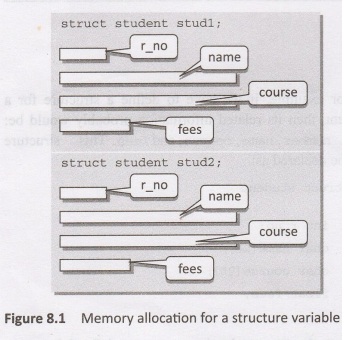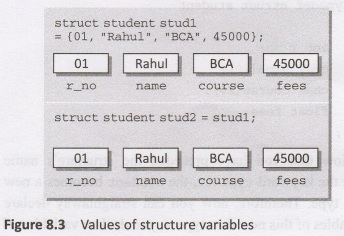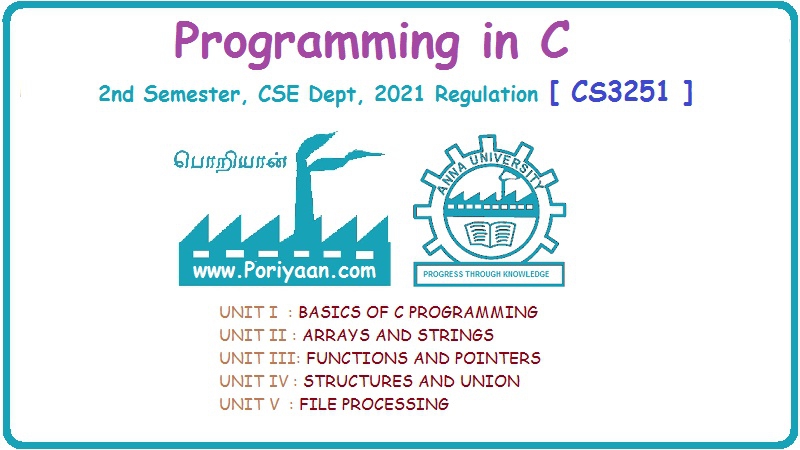Programming in C: Unit IV: Structures and Union
Structure
with Example C Programs
A structure is similar to records. It stores related information about an entity. A structure is a user-defined data type that can store related information (even of different data types) together.
Unit IV : Structure and Union
CHAPTER
9 : STRUCTURE AND UNION
Takeaways
•
Structure declaration, initialization, and access
•
Structures and Functions
•
Arrays of unions
•
Enumerated data type
•
Nested structures
•
Self-referential structures
•
Unions within structures
•
Arrays of structures
•
Unions
•
Structure within unions
INTRODUCTION
A
structure is similar to records. It stores related information about an entity.
A structure is a user-defined data type that can store related information
(even of different data types) together. The major difference between a
structure and an array is that, an array contains related information of the
same data type.
A
structure is, therefore, a collection of variables under a single name. The
variables within a structure are of different data types and each has a name
that is used to select it from the structure.
Structure Declaration
A
structure is declared using the keyword struct followed by a structure name.
All the variables of the structure are declared within the structure. A
structure type is generally declared by using the following syntax:
Programming Tip:
Do
not forget to place a semicolon after the definition of structures and unions.
struct struct-name
{
data_type var-name;
data_type var-name;
};
For
example, if we have to define a structure for a student, then its related
information probably would be: roll_number, name, course, and fees. This can be
declared as:
struct student
{
int r_no;
char name [20];
char course [20];
float fees;
};
Now,
the structure has become a user-defined data type. Each variable name declared
within a structure is called a member of the structure. The structure
declaration, however, does not allocate any memory or consume storage space. It
just gives a template that conveys to the C compiler how the structure should
be laid out in memory and gives details of the member names. Like any other
data type, memory is allocated for the structure when we declare a variable of
the structure. For example, we can define a variable student by writing
struct student stud1;
Here,
struct student is a data type and stud1 is a variable. Look at another way of
declaring variables. In the following syntax, the variable is declared at the
time of structure declaration.
struct student
{
int r no;
char name [20];
char course [20];
float fees;
}stud1, stud2;
In
this declaration we declare two variables stud1 and stud2 of the structure
student. So if you want to declare more than one variable of the structure,
then separate the variables using a comma.
When
we declare variables of the structure, separate memory is allocated for each
variable. This is shown in Figure 8.1.

Let
us see some more structure declarations.
Example 1
Declare a structure to store
information about a point in the coordinate system.
struct point
{
int x,y;
};
Example 2
Declare a structure to store
customer information.
struct customer
{
int cust id;
char name [20];
char address [20];
long int phone_num;
int DOB;
};
Example 3
Declare a structure to store
information of a particular date.
struct date
{
int day;
int month;
int year;
};
Example 4
Declare a structure to store
information of a particular book.
Programming Tip: Use
different member names for different structures for clarity.
struct BOOK
{
char title [20];
char author [20];
int pages;
float price; T
int yr_of_publication;
};
Example 5
Declare a structure to create an
inventory record.
struct inventory
{
char prod_name [20];
float price;
int stock;
};
Note
Structure
type and variable declaration of a structure can be either local or global
depending on their placement in the code.
Last
but not the least, structure member names and names of the structure follow the
same rules as laid down for the names of ordinary variables. However, care
should be taken to ensure that the name of structure and the name of a
structure member should not be the same. Moreover, structure name and its
variable name should also be different.
Typedef Declarations
Programming Tip:
C
does not allow declaration of variables at the time of creating a typedef
definition. So variables must be declared in an independent statement.
The
typedef (derived from type
definition) keyword enables the programmer to create a new data type name from
an existing data type. By using typedef,
no new data is created, rather an alternate name is given to a known data type.
The
general syntax of using the typedef keyword is given as:
typedef existing data_type new data_type
Note
that typedef statement does not
occupy any memory, it simply defines a new type. For example, if we write
typedef int INTEGER;
then
INTEGER is the new name of data type int. To declare variables using the new
data type name, precede the variable name with the data type name (new).
Therefore, to define an integer variable, we may now write
INTEGER num=5;
When
we precede a struct name with typedef keyword, then the struct becomes a new type. It is used
to make the construct shorter with more meaningful names for types already
defined by C or for types that you have declared. A typedef declaration is a
synonym for the type. For example, writing
typedef struct student
{
int r_no;
char name [20];
char course [20];
float fees;
};
Now
that you have preceded the structure's name with the keyword typedef, the student becomes a new data type. Therefore, now you can
straightaway declare variables of this new data type as you declare variables
of type int, float, char, double,
etc. To declare a variable of structure student you will just write
student stud1;
Note
that we have not written struct student
stud1.
Initialization of Structures
A
structure can be initialized in the same way as other data types are
initialized. Initializing a structure means assigning some constants
to the members of the structure. When the user does not explicitly initialize
the structure, then C automatically does that. For int and float members,
the values are initialized to zero and char
and string members are initialized to '\0' by default (in the absence of any
initialization done by the user).
The
initializers are enclosed in braces and are separated by commas. However, care
must be taken to see that the initializers match their corresponding types in
the structure definition.
The
general syntax to initialize a structure variable is noitasilaitini given as
follows:
struct struct name
{
data_type member_name1;
data_type member_name2;
data_type member_name3;
…………………………………………..
}struct_var {constantl, constant2, constant
3,... };
OR
Programming Tip:
It
is an error to assign a structure of one type to a structure of
another
type.
struct struct name
{
data_type member_name1;
data_type member_name2;
data_type member_name3;
……………………………………………
};
struct struct_name struct_var
={constant1, constant2, constant 3,...};
For
example, we can initialize a student structure by writing
struct student
{
int r_no;
char name [20];
char course [20];
float fees;
}stud1 = {01, "Rahul",
"BCA", 45000};
or
by writing
struct student stud1 = {01,
"Rahul", "BCA", 45000};
Figure
8.2 illustrates how the values will be assigned to the individual fields of the
structure.

When
all the members of a structure are not initialized, it is called partial
initialization. In case of partial initialization, first few members of the
structure are initialized and those that are uninitialized are assigned default
values.
Accessing the Members of a Structure
Each
member of a structure can be used just like a normal variable, but its name
will be a bit longer. A structure member variable is generally accessed using a
'.' (dot) operator. The syntax of accessing a structure or a member of a
structure can be given as:
Struct_var. member_name
Programming Tip:
A
member of the structure cannot be accessed directly using its name. Rather you
must use the structure name followed by the dot operator before specifying the
member name.
The
dot operator is used to select a particular member of the struc- ture. For
example, to assign value to the individual data members of the structure
variable stud1, we may write
studl.r_no = 01;
stud1.name = "Rahul";
stud1.course = "BCA";
stud1.fees = 45000;
To
input values for data members of the structure variable stud1, we may write
scanf("%d", &stul.r_no);
scanf("%s", stud1.name);
Similarly,
to print the values of structure variable stud1,
we may write
printf("%s",
stud1.course);
printf("%f", stud1.
fees);
Memory
is allocated only when we declare variables of the structure. In other words,
memory is allocated only when we instantiate the structure. In the absence of
any variable, structure definition is just a template that will be used to
reserve memory when a variable of type struct
is declared.
Once
the variables of a structure are defined, we can perform a few operations on
them. For example, we can use the assignment operator '=' to assign the values
of one variable to another.
Note
Of
all the operators ->,.,(), and [] have the highest priority. This is evident
from the following statement:
stud1.fees++
will be interpreted as (stud1. fees) ++
Copying and Comparing Structures
We
can assign a structure to another structure of the same type. For example, if
we have two structure variables studl and stud2 of type struct student given as
Programming Tip:
An
error will be generated if you try to compare two structure variables.
struct student stud1 = {01,
"Rahul", "BCA", 45000};
struct student stud2;
Then
to assign one structure variable to another we will write,
stud2 = stud1;
This statement initializes the members of stud2 with the values of members of stud1. Therefore, now the values of stud1 and stud2 can be given as shown in Figure 8.3.

C
does not permit comparison of one structure variable with another. However,
individual members of one structure can be compared with individual members of
another structure. When we compare one structure member with another
structure's member, the comparison will behave like any other ordinary variable
comparison. For example, to compare the fees of two students, we will write
if (studl.fees > stud2. fees)
Fees of studl is greater than stud2
1.
Write a program using structures to read and display the information about a
student.
#include <stdio.h>
#include <conio.h>
int main()
{
struct student
{
int roll_no;
char name [80];
float fees;
char DOB [80];
};
struct student stud1;
clrscr();
printf("\n Enter the roll
number: ");
scanf("%d",
&studl.roll_no);
printf("\n Enter the name:
");
scanf("%s", stud1.name);
printf("\n Enter the fees:
");
scanf("%f", &stud1.fees);
printf("\n Enter the DOB:
");
scanf("%s", stud1. DOB);
printf("\n *******STUDENT'S
DETAILS******* " ");
printf("\n ROLL No. =
%d", stud1.roll_no);
printf("\n NAME = %s",
stud1.name);
printf( "\n FEES = %f",
stud1. fees);
printf("\n DOB = %s",
stud1. DOB);
getch();
return 0;
}
Output
Enter the roll number: 01
Enter the name: Rahul
Enter the fees: 45000
Enter the DOB: 25-09-1991
*******STUDENT'S DETAILS *******
ROLL NO. = 01
NAME = Rahul
FEES = 45000.00
DOB = 25-09-1991
2.
Write a program, using structures to find the biggest of three numbers.
#include <stdio.h>
#include <conio.h>
int main()
{
struct numbers
{
int a, b, c;
int largest;
};
struct numbers num;
clrscr();
printf("\n Enter the three
numbers: ");
scanf("%d %d %d",
&num. a, &num. b, &num. c);
if (num.a > num.b &&
num.a > num. c)
num. largest = num.a;
if (num.b > num. a &&
num.b > num.c)
num.largest = num.b;
if (num.c > num. a &&
num.c > num. b)
num. largest = num.c;
printf("\n The largest number
is: %d", num. largest);
getch();
return 0;
}
Output
Enter the three numbers: 7 9 1
The largest number is: 9
3.
Write a program to read, display, add, and subtract two complex numbers.
#include <stdio.h>
#include <conio.h>
int main()
{
typedef struct complex
{
int real;
int imag;
} COMPLEX;
COMPLEX c1, c2, sum_c, sub_c;
int option;
clrscr();
do
{
printf("\n
**** MAIN MENU ****");
printf("\n
1. Read the complex nos.");
printf("\n
2. Display the complex nos.");
printf("\n 3. Add the complex
nos.");
printf("\n
4. Subtract the complex nos.");
printf("\n
5. EXIT");
printf("\n
Enter your option: ");
scanf("%d",
&option);
switch
(option)
{
case
1:
printf("\n
Enter the real and imaginary parts of the first complex number: ");
scanf("%d
%d", &c1. real, &cl.imag);
printf("\n
Enter the real and imaginary parts of the second complex number: ");
scanf("%d
%d", &c2. real, &c2.imag);
break;
case
2:
printf("\n
The first complex number is: %d %di", c1. real, cl.imag);
printf("\n
The second complex number is: %d %di", c2. real, c2.imag);
break;
case
3:
sum_c.real
= c1. real + c2. real;
sum_c.imag=
c1.imag + c2.imag;
printf("\n
The sum of two complex numbers is: %d+%di", sum_c.real, sum_c.imag);
break;
case
4:
sub_c.real
= c1.real - c2.real;
sub_c.imag
= c1.imag - c2.imag;
printf("\n
The difference between two complex numbers is: %d + %di", sub_c.real,
sub_c.imag);
break;
}
}
while (option != 5);
getch();
return
0;
}
Output
********
MAIN MENU ****
1.
Read the complex numbers
2.
Display the complex numbers
3.
Add the complex numbers
4.
Subtract the complex numbers
5.
EXIT
Enter
your option: 1
Enter
the real and imaginary parts of the first complex number: 2 3
Enter
the real and imaginary parts of the second complex number: 4 5
********
MAIN MENU *********
1.
Read the complex numbers
2.
Display the complex numbers
3.
Add the complex numbers
4.
Subtract the complex numbers
5.
EXIT
Enter
your option: 3
The
sum of two complex numbers is: 6 + 8i
4. Write a program to
enter two points and then calculate the distance between them.
#include
<stdio.h>
#include
<conio.h>
#include
<math.h>
int
main()
{
typedef
struct point
int
x, y;
}
POINT;
POINT
p1, p2;
float
distance;
clrscr();
printf("\n
Enter the coordinates of the first point: ");
scanf("%d
%d", &pl.x, &pl.y);
printf("\n
Enter the coordinates of the second point: ");
scanf("%d
%d", &p2.x, &p2.y);
distance
= sqrt (pow((pl.x p2.x), 2) + pow((pl.y p2.y), 2));
printf("\n
The coordinates of the first point are: %dx %dy", pl.x, pl.y);
printf("\n
The coordinates of the second point are: %dx %dy", p2.x, p2.y);
printf("\n
Distance between p1 and p2 = %f", distance);
getch();
return
0;
}
Output
Enter
the coordinates of the first point: 2 3
Enter the coordinates of the second
point: 9 9
The coordinates of the first point
are: 2x 3y
The coordinates of the second point
are: 9x 9y
Distance between p1 and p2 =
9.219544
Programming in C: Unit IV: Structures and Union : Tag: : with Example C Programs - Structure
Related Topics
Related Subjects
Programming in C
CS3251 2nd Semester CSE Dept 2021 | Regulation | 2nd Semester CSE Dept 2021 Regulation
